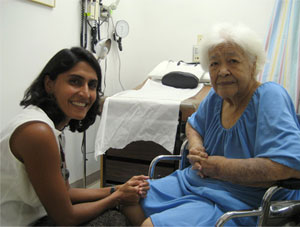HRSA Scholarship Leads Internist to Saipan

It's midnight on the Island of Saipan and Dr. Divya Sharma has had a long day, but despite the late hour, she's still eager to talk about the great need for more health care providers in her community.
"I'm always recruiting," she said. "It's hard in a lot of ways being here. The money isn't as great here and it's a long way away. A lot of people don't want to go so far."
Yet, Sharma is committed to her work and her location.
Sharma is a HRSA scholar. In exchange for a 2-year scholarship for University of New Mexico Medical School from National Health Service Corps she agreed to work in an area with a great shortage of health care providers. After Medical School, she completed her residency in Internal Medicine from the University of Virginia, and chose to work on one of the U.S. territories, Saipan, part of the Commonwealth of the Northern Mariana Islands, north of Guam and about as far as one can get from the continental United States and still be considered part of the United States. She and her family-a husband and two young children-moved to Saipan more than two years ago. She recently completed her agreement with NHSC scholar program and signed on for two more years of service.
"Part of my other passion is global health or international health," said Sharma, who completed her two required years and just signed on for two more. So she and her husband looked at their options and chose Saipan for its diverse population and opportunity to make a difference.
"It's a wonderful community and I really love my patients," she said. "But there are frustrations. Sometimes we run out of basic equipment to diagnose things so we have to get creative."
"Community outreach can be interesting when your patients don't have a telephone. And gas prices are fairly high here, with no public transportation access to care is a problem."
The other day, Sharma ran into a patient in the grocery store and took advantage of the opportunity to treat him. "I wrote a lab order and a prescription on the back of a receipt right there, and told her to follow up with me in clinic in one week" she said.
The other great challenge is that there is no tertiary care facility nearby. If a patient requires that level of hospital care, the trip can take 6-12 hours from our hospital to another.
"Anywhere else-even in Alaska and Hawaii-you are not very far from a tertiary care center," she said. "We don't have a close by tertiary care center, so patients have to go to the Philippines or Hawaii."
Sharma said she wasn't prepared to have to travel with critically ill patients on commercial airlines, but she adjusted. "You just hope your patient doesn't crash while you're on the plane," she said.
But Sharma is up to the challenges. "The reason I went in to medicine is because I wanted to serve in an underserved area," she said.
- National Health Service Corps clinicians serve in all 50 States, the District of Columbia, and every U.S. territory.
- 60 percent work in rural and frontier America, 40 percent in inner cities.
- Most stay beyond their 2-year service commitment: 68 percent stay at least 5 years and 52 percent stay at least 15.

